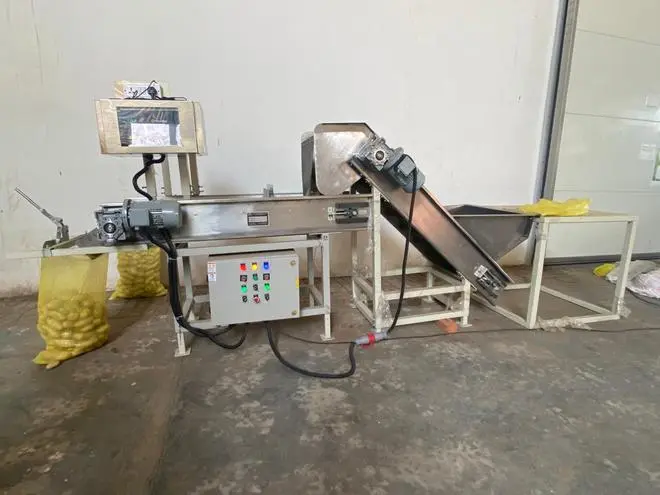Potato processors are looking to extend the spud’s shelf life by setting up state-of-the-art cold storage and cutting manual handling.
Cold storage is very crucial for the potato business because processors need supplies throughout the year. Potatoes are grown between October and February, sometimes extending to March, they need the spud at least until the arrival of the new crop.
According to S Soundararadjane, Chief Executive Officer (CEO) of HyFarm, there are three types of storage — bags cold storage, a traditional one, bulk cold storage and box cold storage.
“Normally, the bag cold storage, where potatoes are stored in bags, can help store quality potatoes for six to eight months. But the bulk and box cold storage can store potatoes for 10-11 months,” he told businessline.
Rise in sugar content
Since bulk and box storage have the technology to help the potatoes store longer, they are better than the bag cold storage. However, processors store potatoes for short-term in the bag cold storage. For the long-term, bulk or box storage come into play.
Processors require potatoes around the year, and one of the problems that could crop up is that after 10 months, the sugar content in the spud used for French Fries and crisps could increase. This is ideally not suitable for these products.
Also, any delay in planting could affect arrivals. This, in turn, will leave the processor’s capacity idling due to a supply shortage.
The cost of storing potatoes in bag cold storage, where labourers store potatoes in 50-kg bags, is ₹2.45 a kg. However, storing in bulk or box storage is costly. The cost of storage in bulk storage is ₹5.40 a kg and for the box storage, it is an additional ₹0.20 per kg.

The quality of potatoes being checked at a bulk cold storage
Undergoing turbulence
“But the advantage we have is that potatoes can be stored for a longer term with 5 bulk cold stores meeting our requirements,” the CEO of HyFarm, a unit of Ahmedabad-based HyFunFoods Ltd, said.
Potato losses are higher in bag cold storage for several reasons. The main reason is that human labour is deployed for loading and unloading. This causes potatoes to undergo a lot of “turbulence,” leading to losses. So, to minimise such losses, the processors have begun to opt for bulk and box cold storage.
“In Gujarat, we have around 400 cold storages. Of these, only 14 are bulk cold stores and another three are box cold stores. People prefer bag cold storage because of cost consciousness, and the alternatives are expensive,” said Soundararadjane.
It is not just HyFarm or processors in Gujarat who are looking for such solutions. The Central Potato Research Institute -ICAR (CPRI-ICAR), Shimla, has stressed the need for better storage technology in its “Vision 2050” document.
Post-harvest losses
According to the institute, post-harvest losses in potatoes are 16 per cent, while the losses in seed are 8.5 per cent and in processing are 7.5 per cent. “… lack of state-of-the-art cold storage facilities and massive transportation of potatoes from northern to southern states are the causes of the high wastage of potatoes in absolute terms…,” it said.
The CPRI-ICAR said the target to cut post-harvest losses is 10 per cent by 2050.
Soundararadjane said technology plays a major role in storing potatoes. Modern cold storage has been automated as much as possible. Potatoes are now loaded from the farm in jumbo bags, which are lifted on a hook and loaded onto 25-tonne Tipper trucks. Once the trucks reach the storage, the potatoes are put on a hopper and then everything is automated, including sorting and storing.
“There is minimal labour interference, and the quality is assured as the spuds are not loaded in bags and dropped in two to three places. It also saves the labour costs of ₹16 per bag, which is part of the overall storage cost,” the HyFarm CEO said.
Concept catching up
But the concept of modern cold storage is catching up. For example, HyFarm has taken four bulk cold storage units on rent. Other processors, such as McCain India, are also adapting the concept. McCains has box cold storage for its seeds and PepsiCo has for raw materials.
Processors’ thought process now is to set up cold storage near the manufacturing facility. “Potatoes have to reach the processing unit within 2-4 hours. If it takes 6-8 hours, the quality of the products get affected,” said Soundararadjane.
“One of the fundamental things most of the companies are focusing on is to build those modern cold storages – bulk or box – close to or in the same vicinity where the plant is set up. It will help to reduce the losses in a big way,” he said, adding they are looking for centralised cold storage solutions.
Apart from Gujarat, such developments are taking place in Madhya Pradesh too. Efforts are on to reduce the cost of bulk and box cold storage.
Lowering costs
One way of bringing down storage cost could be to increase the height of box storage so that 30-50 per cent of additional space would be available. “It could pick up very well,” the HyFarm CEO said.
The advantage of box cold storage is that potatoes can be sorted out size-wise – A (small), AA (medium) and AAA (large) – and take out the material for different purposes as per requirement. Each box, imported from Belgium or Poland, can store up to 0.5- 1.0 tonnes of potatoes.
The box storage requires an initial investment, which is a big challenge, but it can last for 10-15 years, said Soundararadjane.
Published on April 30, 2025


